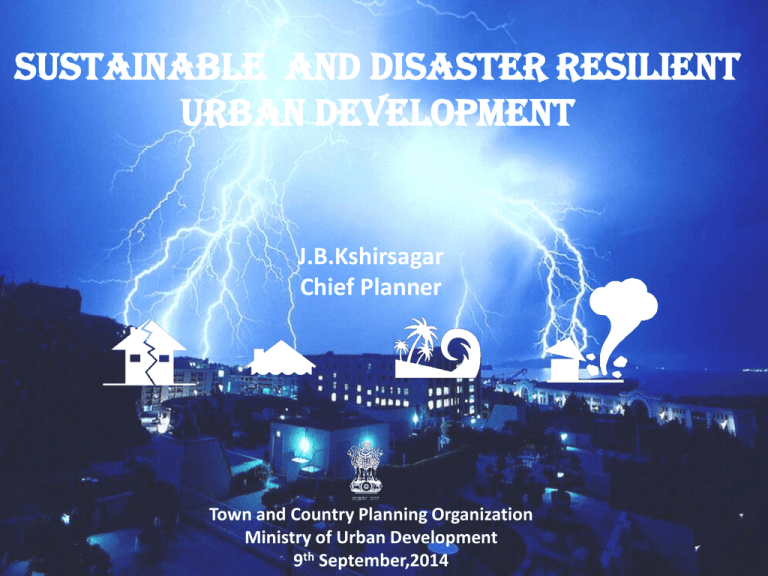Disaster Management Plan
advertisement

SUSTAINABLE AND DISASTER RESILIENT URBAN DEVELOPMENT J.B.Kshirsagar Chief Planner Town and Country Planning Organization Ministry of Urban Development 9th September,2014 VULNERABILITY TO DISASTER The Indian Sub continent is vulnerable to various kinds of disasters. Some of the Natural disasters have been highlighted in the presentation Earth quake Urban Flooding Tsunami Cyclone Presentation highlights the different types of Natural Disaster and Efforts towards mitigation of disaster. CITIES/TOWNS FALLING IN SEISMIC VULNERABLE ZONES Earthquake ZoneV -Very High Risk Zone: (Intensity 9 and above) Srinagar, Dharamshala, Guwahati, Shillong, Aizawl, Agartala, Imphal, Jorhat, Kohima, Tezpur, Itanagar, Bhuj and Port Blair. Zone IV – High Risk Zone: (Intensity 8) Jammu, Shimla, Amritsar, Jalandhar, Chandigarh, Delhi, Meerut, Gorakhpur, Naintal, Roorkee, Patna, Gangtok and Jamnagar. Zone III - Moderately Risk Zone: (Intensity 7) Agra, Lucknow, Varanasi, Dhanbad, Asansol, Kolkata, Ahmedabad, Vadodara, Indore, Surat, Nashik, Pune, Mangalore, Chennai, Kochi and Trivandrum. About 59% of land area liable to seismic hazard damage Seismic zonation and intensity map of India-2002 FACTORS RESPONSIBLE OF EARTHQUAKE RELATED DISASTERS Location of cities/towns in seismic areas, especially on poorly consolidated soils, on ground prone to landslips or along fault lines. Building Infrastructure such as houses, bridges, dams, which are not resistant to ground motion. Unreinforced masonry buildings with heavy roofs are more vulnerable . High density of buildings per hectare with high occupancy(high rise high density) without any room for ingress and egress of fire-tenders/vehicles for emergency measures. Lack of access to information about earthquake risks. ATTEMPT FOR BUILDING REGULATION TOWARDS EARTHQUKE SAFETY After the Bhuj earthquake, Gujarat incorporated structural safety of the Buildings in the Building Bye-Laws. Ministry of Urban Development amended the Unified Building Bye-laws, 1983 of Delhi to incorporate structural safety /stability provisions in 2001. Ministry of Home Affairs constituted a Committee to formulate Model Building Bye-Laws and Review all Town and Country Planning Act and the Zoning Regulations in Jan, 2004. Prof. Arya Committee Report (MHA): MHA constituted the Prof. Arya Committee in 2007. In 2008, the Prof. Arya Committee Reports were also circulated to all the State Governments. Four important aspects of report: Amendments in the Town & Country Planning/ Urban Development Acts. Zoning regulations. Additional Provisions in Development Control Regulations for Safety. Additional Provisions in Building Regulations/Byelaws for Structural Safety In Natural Hazard Zones of India. Details of various BIS codes relating to Structural Safety for natural hazard are given for the guidance of the professionals to design structures/buildings, keeping in view of the provisions of such codes to combat different natural hazards. Revised Model Building Bye-laws,2014 Model Building Bye-laws, 2004 brought out by Ministry of Urban Development prescribed Structural Safety in Chapter 5. The revised Model Building Bye-Laws, 2014 incorporates the Prof. Arya Committee recommendations: • • • • • • • • • • • • • • Structural Design And Safety Additional Provisions In Building Regulations/ Bye-laws For Natural Hazard Prone Areas Occupant Load and Structural Design Basis Report Seismic Strengthening/Retrofitting Review Of Structural Design Certification Regarding Structural Safety In Design Constructional Safety Quality Control And Inspection Structural Requirements Of Low Cost Housing Issue Of Occupancy Certificate Protective Measures In Natural Hazard Prone Areas Registration Of Professionals Professional Fees For SER/SDAR And CER/CMAR Alternative Materials, Methods Of Design And Construction And Tests CITIES/TOWNS /DISTRICTS FALLING IN VULNERABLE ZONES for URBAN FLOODING Urban Flooding (Over 40 million hectares (12 per cent of land) is prone to floods and river erosion) Cities having Average Annual Rainfall < 1000 mm Ahmedabad ,Bengaluru , Hyderabad ,jaipur, New Delhi, Srinagar. Cities having Annual Rainfall from 1000 to 1500 mm Bhopal, Chennai, Chandigarh, Lucknow, Nagpur, Patna. Cities having Average Annual Rainfall above 1500 mm Bhubaneswar, Goa, Guwahati, Kolkata, Mumbai, Thiruvananthapuram FACTORS RESPONSIBLE FOR URBAN FLOODING Violations of Zoning regulations in congested areas. Unorganized development in form of slums/squatters encroaching natural drainage channels, thereby leading to urban flooding. Silting up of catchment basins and drains with overflow of drains. Constructions spanning this area in and around the River Plains and specially in the low lying Flood Plains results in the change of flow patterns in the rivers. MEASURES TO MITIGATE URBAN FLOODIND Master Plan of a town, areas vulnerable to flooding are to be delineated for which Flood zoning Maps are to be prepared and appropriate development control is to be prescribed based on the degree of risk associated. An inventory of drainage and sewerage system for the entire city is to be prepared and mapped into Utility maps. Water logging, Sewerage and Drainage improvement /augmentation needs can be addressed. Water Resource Management Plan is needed for identifying areas receiving high rainfall and low rainfall along with coefficient of runoff. Action plan for preventive measures like raising the height of river embankment, afforestation in the catchment areas of river, periodic review of water flow from the barrages and information on the water discharge so that steps may be taken in advance to rehabilitate people likely to be affected by floods. MEASURES TO MITIGATE URBAN FLOODING Strict enforcement of Zoning regulations and Building Bye-Laws is needed in flood prone areas. In Master Plans, the Flood plains need to be declared as litter free and no construction zone and may be designated for intensive agriculture/horticulture. For major land use changes, impact assessment should be made mandatory for the towns with sparse open spaces / green or are vulnerable to encroachment / development to reduce the chances of flooding. Slope analysis and runoffs need to be assessed with areas of natural vegetation and plans must take these aspects into account. Strict periodic cleaning of urban drains and sewer lines is to be carried out by the ULBs and Development Authorities including screening chambers to reduce the chances of flooding during monsoons. CITIES/TOWNS /DISTRICTS FALLING IN TSUNAMI VULNERABLE ZONES Tsunami (5,700 km coastline is prone to Tsunamis) Tsunami Zone are defined as: Zone-1 maximum water depth 0-3m Zone-2 maximum water depth 3-6m Zone-3 maximum water depth 6-9m Zone maximum water depth > 9 m Coastal State Tamil Nadu ,Puducherry, Andhra Pradesh, Orissa, West Bengal, Andaman & Nicobar, Gujarat, Dadra & Nagar Haveli, Daman & Diu, Maharashtra, Goa, Karnataka ,Kerala Lakhsadweep. Maximum Storm Surge in meters for each coastal District FACTORS RESPONSIBLE OF TSUNAMI RELATED DISASTERS Tsunami are ocean waves caused by under sea Volcanic Eruptions, Earthquakes and Landslides with waves travelling at high speeds. • Coastal Towns are prone to Tsunami hazards for their proximity to shores. • Landuse and habitation density in the Tsunami prone Coastal Zone also determines the extent of damage and loss. • Environmental degradation due to urbanization. • Haphazard urbanization along the coastal areas. • Preparedness and Early warning systems and their efficiency. MEASURES to MITIGATE- TSUNAMI DISASTERS Preparation of coastal land use map on large scale. Strict Implementation of the CRZ regulations for planning Costal Towns. Planned layouts with easy “Evacuation routes” in case of early and swift evacuation. Low rise, medium density developments beyond the CRZ in prone coastal towns. Provisions of Early Warning systems by the Local Authorities Community Based- Costal Zone Management and Community Based Information Systems. CITIES/TOWNS /DISTRICTS FALLING IN VULNERABLE CYCLONE ZONES Cyclone (5,700 km coastline is prone to cyclones) Very High Damage Risk Zone –B (Vb= 50 m/s) East Godavari, Krishna, Guntur, Prakasam, Vizianagaram, Nellore, Visakhapatnam , srikulam, Kachchh,Junagadh, Cuttack, Ganjam, Jagatsinghpur, Kendrapara, Khurdha, Puri, Balasore, Bhadrak, Jajpur, Thanjavur, Cuddalore, Kanchipuram,Tiruvallur, Tiruvanamalai,Viluppuram,Ramanathapuram, Nagapattinam,Thoothukudi,Tirunelveli High Damage Risk Zone (Vb=47 m/s) Moderate Damage Risk Zone-A (Vb=44 m/s) Moderate Damage Risk Zone-B (Vb=33m/s) where Vb is – Basic Wind Speed FACTORS RESPONSIBLE OF CYCLONE RELATED DISASTERS Cities and towns are prone to Cyclone hazard due to: • Climate Change Patterns. • Environmental changes and degradation. • Loss of Green Cover and Mangroves along the shoreline. Cyclone related hazards for coastal towns: • Flooding- Coasts and Inland • Beach Erosion. • Damage to Structures. • Loss of Power and Communication • Land Subsistence •Crop Destruction • Contamination of water and food. • Injuries and loss of life. STEPS NEED TO BE TAKEN FOR PREVENTING DISASTER FROM TOWN PLANNING POINT OF VIEW Planning is a sequential and continuous process, involving a series of measures and steps at various levels. Formulation of Spatial Master Plan involves coordinated Sectoral plans, effective management of disaster needs clear-cut priorities and appropriately coordinated actions between Central and State governments. New buildings approvals to be in consonance with earthquake resistant regulations and all existing buildings to be rigorously checked for structural stability. Disaster Management Plan should be integrated within the context of overall Master Plan. Existing land-use maps needs to indicate hazard prone areas keeping in view the regulations for Land Use Zoning and regulations for Natural Hazard Prone areas. Mapping and Mitigation Plan for Unregulated mixed land use developments on narrow streets to evacuate in disaster event. STEPS NEED TO BE TAKEN FOR PREVENTING DISASTER FROM TOWN PLANNING POINT OF VIEW Area / buildings for evacuation purposes and temporary shelter to be earmarked. Detailed GIS and remote sensing based micro-zonation and hazard maps need to be prepared and revising and updating the Vulnerability Atlas for all States. The State Town and Country Planning Departments, Development Authorities, ULBs and State Disaster Management Agencies need to work in close coordination. Need for Capacity Building of town planners, engineers and architects in safe design and construction of new buildings and for strengthening of existing unsafe buildings and structures through retrofitting. Disaster-resistant features specified in National Building Code should be adhered to. DISASTER MITIGATION PARAMETERS ADDRESSED IN VARIOUS PLAN (as per URDPFI Guidelines,2014) Plans Parameters Perspective Plan • Climatological studies, identification of areas prone to hazards • Transportation-analysis of the existing network • Social and Physical Infrastructure Regional Plan • Settlement pattern • Transportation Network • Social and Physical Infrastructure • Environmentally sensitive areas- Hazard prone zones such as earthquake, floods/ flash floods, high winds, cyclone, fire, land slide, tsunami, vulnerability and risk assessment of the region Development Plan • Hazard prone zones such as earthquake, floods/flash floods, high winds, cyclone, fire, land slide, tsunami • Disaster mapping - vulnerability and risk assessment of the region • All environmentally sensitive areas • Assessment of Disaster management infrastructure to meet the requirement of prescribed in the District Disaster Management Plan DISASTER MITIGATION PARAMETERS ADDRESSED IN VARIOUS PLAN (as per URDPFI Guidelines,2014) Plans Parameters Local Area Plan • Strategy for hazard zone and regulations City Development Plans Special Purpose Plan •Existing situation •Disaster prevention and management plan •Investment estimates •Training and other programs •Information management system •Implementation plan Disaster Management Plan (as per NDMA guidelines) DISASTER MANAGEMENT STRATEGIES FOR DIFFERENT SECTORS (URDPFI Guidelines,2014) Parameters Strategy Housing •Guidelines for construction of buildings on slopes •Structural stability of buildings in hills and for the entire GMA •Soil erosion and sedimentation control for construction in non-hill areas Ecologically sensitive urban planning •Demarcate eco-sensitive areas in the city as low/ no built up areas •Bring in principles of climate resilient urban development based on environmental parameters like conservation of natural ecosystems, natural drainage patterns Urban infrastructure and services •Augment the piped water supply network in the city •Augment the water treatment capacity of the city •Water Conservation and Rainwater harvesting •Development of a sewerage system •Monitoring water quality at disposal points •Integrated natural drainage plan for the city •Prepare and implement a storm water drainage plan Disaster Resilience •Preventive health measures •Public health management and surveillance system •Emergency medical response BUFFERS FOR VARIOUS ACTIVITIES (URDPFI Guidelines,2014) Parameters Buffer Zone Natural hazard zones such River flood plains and water bodies including wetlands Area likely to be affected by floods (up to 10-year frequency) reserved only for gardens, parks, playgrounds, etc. All other habitable buildings to be prohibited in this zone. Area liable to flooding (25-year frequency): Residential buildings could be permitted with certain stipulation of construction on stilts (columns), minimum plinth levels, prohibition for construction of basements and minimum levels of approach roads, etc. Coastal Regulation Zone Coastal land up to 500 m from the High Tide Line (HTL) landward side and a stage of 100 m along banks of creeks, estuaries, backwater and rivers subject to tidal fluctuations is called the Coastal Regulation Zone, and is regulated for developmental activities BUFFERS FOR VARIOUS ACTIVITIES (URDPFI Guidelines,2014) Parameters Buffer Zone Manmade hazard zones such as radioactive, chemical and gas treatment / processing / distribution lines Chemical Industry Development of buffer zones all around the industry and establish OffSite responding agencies at an appropriate distance from the new installations. Nuclear Plants Exclusion zone: 500 Ha maintained as vacant space and developed as a green belt area. Sterilised Zone: Area of 5 km radius. No restriction is imposed by the plant on organic development activities of population in the annulus between 1.5 and 5 kms. No influx of large population in this area Population Restriction: Population density within 10 km radius: Less than two-third of state average; Population within sterilised zone (5Km radius) Less than 20,000; Population centres with more than 10,000 persons more than 10 km away; Population centres with more than 100,000 person) more than 30 km Some Examples of Good Practices in Disaster Reduction in the context of Urban Planning Practice. BHUJ Pre-disaster scenario layout of a sample block narrow roads with dead ends, irregular plots hinder immediate relief action disaster evacuation process rendered difficult. Post disaster planning layout of a sample block wide roads with loop roads, regular plots, easy access and conducive to immediate action evacuation easy. Good Practices in Disaster Reduction Contd... BHUJ After the earthquake, the State Town Planning Department redeveloped the area through Town Planning Scheme with following features which mitigates disaster. Well connected roads with fewer dead-ends. Increased width of road. Provision of Open spaces. Plots are regular with restrictions on height. PLANNING TOWN & SETTLEMENT: ANDAMAN AND NICOBAR ISLANDS Ministry of Urban Development took the initiative to ensure that the Layout Plans for Permanent Settlements in A & N Islands are taken up in accordance with current town planning norms and that these settlements come up as model townships, catering to the requirements of all facilities and amenities like schools, shopping, health centres, open spaces, govt. and semi govt. establishments, etc. PLANNING TOWN & SETTLEMENT: ANDAMAN AND NICOBAR ISLANDS Plans for Permanent Settlements at 72 locations prepared by TCPO have taken into account topography, socio-economic characteristics, forest resource, etc. and above all located above 3 m contour and beyond the maximum run up of Tsunami so as to minimize the impact of disaster. MINISTRY OF URBAN DEVELOPMENT ROLE IN DISASTER MANAGEMENT For protecting the buildings against earthquake, the State Governments have to incorporate provisions of structural safety and Fire Protection and Safety Requirements in their respective Building Bye-laws. In order to sensitize the State Governments to take necessary action, Ministry of Urban Development have already circulated following documents for the State Governments to adopt provisions: Earthquake tips prepared by IIT Kanpur have been circulated to all the State Governments and the same have been uploaded on the Ministry of Urban Development website. Handbook on Seismic Retrofit of Buildings published by CPWD and IIT, Chennai has been circulated to the State Governments so as to adopt anti-seismic technology in all types of buildings. MINISTRY OF URBAN DEVELOPMENT ROLE IN DISASTER MANAGEMENT Reports of the Committee of Experts under National Seismic Advisor which have suggested appropriate amendments to the Town and Country Planning Acts and Building Bye-Laws to include seismic safety and landuse zoning regulations for hazard prone areas have been circulated to State Government. A National Workshop on incorporating the provisions related to Natural Hazards in State Town and Country Acts, Zoning Regulations and Building Bye-laws in accordance with the recommendations of the Prof. Arya Committee Report was held on 27.1.2013. to sensitize State Government representatives. (Action Taken Report on the recommendations of the Committee) WAY FORWARD Most of the State Government have amended Building Bye - Laws by incorporating provision for Structural Safety. States need to amend their Town and Country Planning Act to incorporate the Prof. Arya Committee report. For all Master Plans which are either being revised or newly formulated, a chapter on Disaster management has to be included. Disaster Management Plan to be prepared for all the cities detailing out areas vulnerable to disaster and accordingly make recommendations for Disaster Mitigation. THANK YOU








